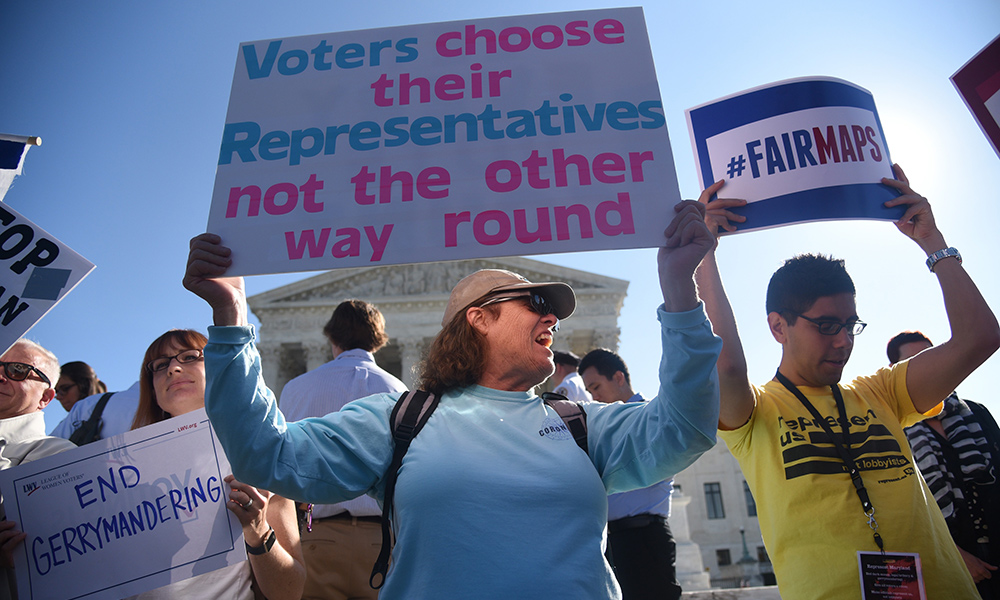December 8, 2021
Protesters gather outside the Supreme Court in 2017 to call for an end to partisan gerrymandering. Gerrymandering is one of the tactics Rochester political scientists focused on in a new study showing how “democracy through deterrence” could collapse in the United States. (Getty Images photo)
A Rochester team introduces the idea of “democracy through deterrence” – and shows why it may be weakening in the United States.
American democracy is in crisis – a majority of scholars and the public agree. Allegations of unfair electoral practices such as voter suppression and gerrymandering, abuse of executive power, and growing concerns about the legitimacy of elections are more common than isolated events in the United States.
If we accept the premise that politicians and parties in general want to stay in power, why should they ever forego dirty tricks to win elections? The answer can be as simple as this: fear of revenge.
Concerns over retaliation by the opposition party may deter the incumbent party from using anti-democratic tactics to win, argues a team of political scientists – Gretchen Helmke and Jack Paine of the University of Rochester and their former colleague Mary Kroeger, now at the University of North Carolina on Kapellenberg. However, they warn that this natural “democratic deterrent” can collapse under certain conditions.
In their recent article in the American Journal of Political Science, Democracy by Deterrence: Norms, Constitutions, and Electoral Tilting, the team argues that self-enforcing democracy requires political parties not to use legal means to overturn electoral rules : Informal norms of mutual restraint and formal constitutional rules are fundamentally intertwined into a “logic of deterrence”.
“By limiting how far each party can legally bend the rules, these legal boundaries create turning points when mutual indulgence or restraint – if you will – collapses,” said Helmke, professor of political science and one of the co-founders of Bright Line Watch. a non-profit monitoring organization of leading political scientists that observes US democratic practices from a comparative perspective.
What is “Democracy Through Deterrence”?
The sentence conveys the idea of a dreaded “tits-for-action” spiral. Republicans, for example, could refrain from using anti-democratic tactics in which they disenfranchise Democratic-minded constituencies in order to avoid a scenario in which the Democrats respond by disenfranchising some Republican-minded constituencies. The team outlines three key factors for understanding the principle of democracy through deterrence in the US: scope, asymmetrical legal boundaries, and partisan sorting.
- Scope. The US has established norms for adhering to the legal interpretation of a written constitution, which means that a military coup or refusal to hold scheduled elections is nearly unthinkable. However, despite tough legal limits in the constitution, there is still considerable legal leeway to change the electoral field. Unlike most developed democracies, the United States does not have a national electoral commission, and state politicians have considerable leeway to determine who can vote and to draw up congressional district boundaries in ways that benefit their own party procured, a practice known as gerrymandering.
- Asymmetrical right boundaries. Restrictions on legally permissible acts do not necessarily affect both parties equally – one side may have more leeway to change the rules than the other, which can lead to a failure of democratic deterrence because the party is less afraid of being punished by the party other side has.
- Partisan sorting. The US Constitution implicitly favors some groups over others. Despite various federal changes that have expanded voting rights, practices such as excluding former felons, requiring photo identification to vote, and deleting electoral rolls have narrowed the scope of voting for some groups. While all of these tactics are legally viable, they are empirically race tied, the political scientists note. Black and Hispanic voters in particular, they argue, face greater hurdles than white voters when politicians impose restrictions on these dimensions.
Kroeger says: “If race correlates to a high degree with party identification or high party sorting – the party that receives disproportionately more support from white voters has greater legal leeway to withdraw supporters of the opposing party. In the US, it is currently the Republican Party. ”Conversely, she adds,“ Unless race is strongly correlated with partisan support, the Republican Party would derive less benefit from using these tactics, which ultimately increases the effectiveness of ‘democracy through deterrence’ would.”
How “democracy through deterrence” collapses
As part of their formal model of “democracy through deterrence”, the team mandates the following:
- When the legal boundaries between the parties are symmetrical, they prevent the electoral rule from being bent by making each party likely to threaten to punish violations by the other.
- however, if the legal barriers become sufficiently asymmetrical, the basis for restraint will crumble. Asymmetries arise when some groups are (a) more prone to legally permissible election bias than others, and (b) groups that are more prone to overwhelmingly vote for one party over the other.
The constitution was of course not written with the parties in mind. However, some features of the constitutional order give some citizens a disproportionate weight, which is reflected in an advantage for the parties, according to Helmke: Districts, while Republicans tend to live in rural districts, then the constitutional order gives the GOP an advantage in gerrymandering itself if both parties want to participate in the practice. “
The political scientists focus in particular on gerrymandering and suffrage / voter suppression in the post-civil period. The fact that the distribution of seats is not proportionally based on the percentage of votes each party receives tends to favor fewer rural voters (mostly Republicans) versus a larger number of urban voters (mostly Democratic), which leads to strong asymmetry. While electoral districts must be the same size, contiguous (with no gaps between members of the same district), and not artificially dispersed, there is no requirement that the percentage of seats held by each party in a state must be equal to the percentage of the vote each party receives.
The team notes that the lack of proportional representation makes it easier for Republican politicians to concentrate large numbers of Democratic voters in a small number of districts that are almost entirely Democratic. As with voter suppression, deterrence fails; Republicans could pursue this strategy with impunity, and Democrats are largely powerless to take revenge, they write.
“Gerrymandering and vote suppression are two key areas of contemporary American electoral politics that really threaten our basic principles of democratic representation,” said Paine, associate professor of political science whose research focuses on authoritarian politics.
“Another worrying development,” adds Paine, “is that these asymmetries now affect another sacred democratic principle – the admission of electoral losses. Republicans seem increasingly inclined to take advantage of the state houses to influence the counting of votes in the 2024 elections. ”This practice can undermine public confidence in fair elections – a necessary hallmark of stable democracy.
What can be done to prevent anti-democratic rule bending?
Narrowing the legal scope for anti-democratic overturning and removal of asymmetries in the US constitution is difficult. According to the team, the barriers to passing federal amendments are high, and the current majority in the Supreme Court has consistently chosen not to intervene on allegations of voting rights or violations of fair district elections.
“But we cannot understand the diseases of current US politics without understanding how deterrence can sustain democracy and why deterrence fails in many facets of American politics,” warns Helmke.
Continue reading

Would you vote for a Democrat who acts like a Republican?
In a recent experiment, a group of political scientists found that when choosing a candidate, party affiliation outweighs a candidate’s political positions and support for democratic norms for both Democrats and Republicans polled.
category: Society & Culture
Why don’t all politicians resort to antidemocratic tactics to stay in power?












/cloudfront-us-east-2.images.arcpublishing.com/reuters/JEUL2B5V7BJCFMRTKGOS3ZSN4Y.jpg)



/cloudfront-us-east-2.images.arcpublishing.com/reuters/DYF5BFEE4JNPJLNCVUO65UKU6U.jpg)

/cloudfront-us-east-2.images.arcpublishing.com/reuters/UF7R3GWJGNMQBMFSDN7PJNRJ5Y.jpg)












